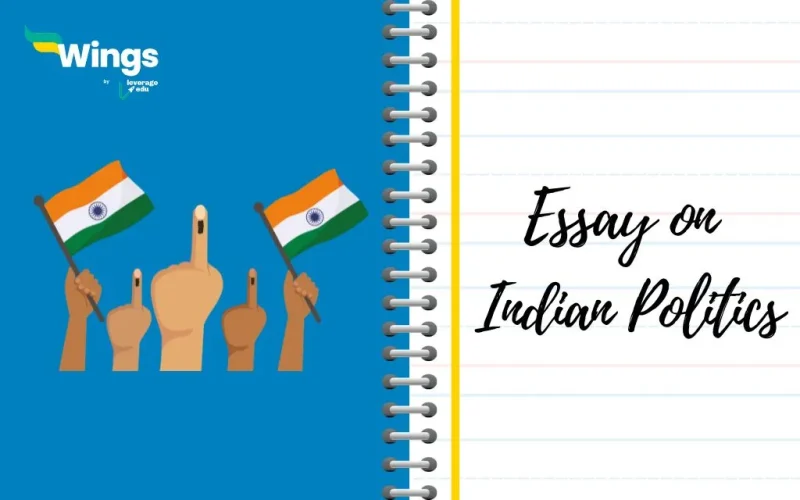Indian Politics Essay: Indian politics plays an important role in shaping the country’s future. As the world’s largest democracy, India follows a parliamentary system where leaders are elected by the people. The government is divided into three main branches: the Legislature, the Executive, and the Judiciary, ensuring a balance of power. Political parties, both national and regional, compete in elections to form the government. While Indian politics has led to significant progress in areas like economic growth and social development, challenges such as corruption, caste-based politics, and policy implementation remain. Understanding Indian politics helps students become informed citizens and encourages them to participate in the democratic process.
Contents
Must Check Out:
Indian Politics Essay in 150 Words
Indian politics has undergone significant changes since independence in 1947. The country follows a democratic system, allowing citizens to elect their leaders through voting. India’s political structure is divided into three main branches: the Legislature, the Executive, and the Judiciary. The Parliament, which consists of the Lok Sabha and the Rajya Sabha, plays a crucial role in lawmaking.
Over the years, Indian politics has witnessed the rise of multiple political parties, including the Indian National Congress (INC) and the Bharatiya Janata Party (BJP). Regional parties also hold significant influence in states like Tamil Nadu, West Bengal, and Uttar Pradesh.
One major challenge in Indian politics is corruption, which affects governance and development. However, recent efforts like digitalization and strict laws have helped improve transparency. Elections are now conducted using Electronic Voting Machines (EVMs), ensuring fair results.
As of 2024, India has over 96 crore registered voters, making it the world’s largest democracy. The youth play a vital role in shaping the future of the nation through informed voting. Indian politics continues to evolve, with a focus on development, economic growth, and global leadership.
Also Read: Essay on Politics
Indian Politics Essay in 250 Words
India follows a multi-party system, which means several political parties compete in elections at the national and state levels. Political parties play a crucial role in representing the interests of citizens and forming the government. The two major national parties are the Bharatiya Janata Party (BJP) and the Indian National Congress (INC). Apart from these, regional parties like the Aam Aadmi Party (AAP), Trinamool Congress (TMC), and Dravida Munnetra Kazhagam (DMK) significantly influence state politics.
Elections in India are conducted every five years, and political parties campaign extensively to win public support. The Election Commission of India (ECI) oversees the election process to ensure fairness. In the 2024 Lok Sabha elections, the voter turnout was approximately 67%, showcasing active public participation.
Despite being a strong democracy, Indian politics faces challenges such as caste-based politics, corruption, and political violence. Many leaders have initiated reforms to address these issues. For instance, digital campaigns and online voting awareness programs have helped increase youth participation.
The future of Indian politics lies in responsible leadership, strong policies, and an engaged electorate. Citizens must vote wisely and hold politicians accountable for their promises. Political parties should focus on development, education, and employment to make India a global powerhouse.
Also Read: One Nation One Election Essay
Indian Politics Essay in 350 Words
Indian politics is a dynamic system that reflects the diversity and aspirations of over 1.4 billion people. As the largest democracy in the world, India has a parliamentary system where leaders are elected by the people through free and fair elections. The President is the constitutional head, while the Prime Minister is the head of the government.
Challenges in Indian Politics
- Corruption: Political corruption remains a serious concern. Scams like the 2G Spectrum and Coal Scam have raised questions about transparency in governance. However, initiatives like the Lokpal Act aim to reduce corruption.
- Caste and Religion-Based Politics: Many political parties use caste and religion to influence voters. This often leads to division in society and affects policy decisions.
- Criminalization of Politics: A significant number of elected representatives have criminal cases against them. Electoral reforms are needed to prevent criminals from entering politics.
- Election-Related Issues: Despite the use of Electronic Voting Machines (EVMs), accusations of electoral fraud and manipulation often arise. Ensuring free and fair elections remains a challenge.
Opportunities and Future Prospects
- Youth Involvement: With over 65% of the population below 35 years, young people can bring fresh ideas and transparency into politics. Initiatives like online voter registration have increased youth participation.
- Digital Governance: The government’s push for digital initiatives like the Digital India campaign has improved efficiency in political administration and governance.
- Women’s Participation: With the Women’s Reservation Bill, more women are expected to enter politics, leading to balanced decision-making.
- Global Influence: India’s strong foreign policies and leadership in organizations like the G20 Summit (2023) and United Nations Security Council (UNSC) have strengthened its global position.
Conclusion
While Indian politics faces multiple challenges, the opportunities for growth and development are immense. With responsible leadership, active public participation, and strong policies, India can overcome political hurdles and emerge as a global leader. The youth and educated citizens must play a proactive role in shaping the future of Indian politics by voting wisely and demanding accountability from their leaders.
Also Read: Essay on Indian Democracy
10 Important Lines on Indian Politics
Here are 10 important lines for an essay on Indian Politics:
- India is the world’s largest democracy, with a parliamentary system of government based on the Constitution of India, which came into effect on January 26, 1950.
- It follows a federal structure with three levels of governance – the central government, state governments, and local bodies (municipalities and panchayats).
- Indian politics is dominated by several national and regional parties. The Bharatiya Janata Party (BJP) and the Indian National Congress (INC) are the two major national parties.
- India conducts regular elections at various levels through the Election Commission of India, including Lok Sabha (House of the People), Rajya Sabha (Council of States), and state legislative assemblies.
- The President of India is the constitutional head of state, while the Prime Minister is the head of government, leading the Council of Ministers.
- The Parliament of India consists of two houses – the Lok Sabha (lower house) and the Rajya Sabha (upper house), responsible for making laws and policies.
- An independent judiciary, led by the Supreme Court of India, ensures the protection of constitutional rights and the rule of law.
- Due to India’s political diversity, coalition governments are common, especially when no single party secures a majority.
- Indian politics involves affirmative action policies, reserving seats for Scheduled Castes (SCs), Scheduled Tribes (STs), and Other Backward Classes (OBCs) to promote social equity.
- Key issues in Indian politics include corruption, communalism, economic inequality, regionalism, and the balance between central and state powers.
Also Read: Essay on Corruption
FAQs
India operates under a federal parliamentary democratic system, meaning it has a central government and individual state governments. Citizens elect their representatives through regular elections.
As of the latest data, India has 2,698 registered political parties. This includes 8 national parties, 52 state parties, and 2,638 unrecognized parties.
The Prime Minister is the head of the government in India, responsible for running the country and making key decisions. The President serves as the ceremonial head of state.
The Indian government is divided into three branches:
Legislature: Makes laws (Parliament).
Executive: Implements laws (Prime Minister and Cabinet).
Judiciary: Interprets laws (Supreme Court and other courts).
The two primary national parties are the Bharatiya Janata Party (BJP) and the Indian National Congress (INC). There are also several influential regional parties across various states.
General elections for the Lok Sabha (House of the People) are held every five years. State assembly elections are also held every five years but may not coincide with national elections.
Indian politics grapples with issues like corruption, caste-based politics, and the criminalization of politics. Efforts are ongoing to address these challenges through reforms and increased transparency.
Students can engage in politics by staying informed about political developments, participating in debates, joining student political organisations, and exercising their right to vote upon reaching the eligible age.
Popular Essay Topics
For more information on such interesting topics, visit our essay writing page and follow Leverage Edu.
 One app for all your study abroad needs
One app for all your study abroad needs














